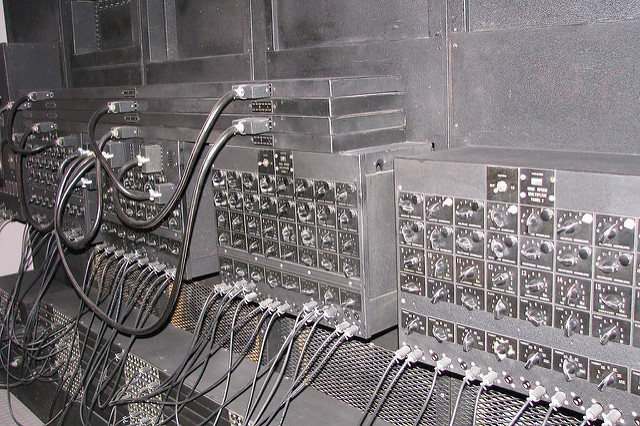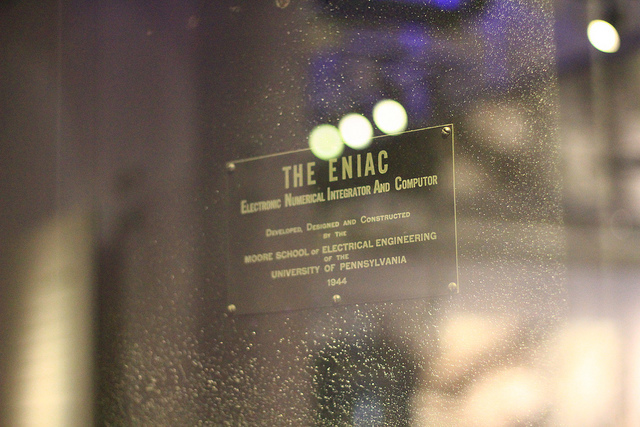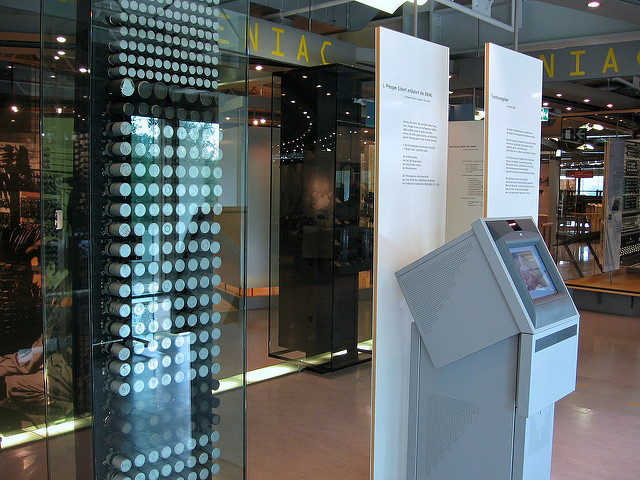Amazing Computer: ENIAC History

/ photo terren in Virginia CC
We in 1cloud write not only about our development experience , but talk about technologies related to various aspects of the functioning of cloud services. Today we turn to history and talk about ENIAC.
')
This amazing computer marked a whole era. The whole history of computer science and computing was divided with its creation on before and after. Let's see at its heyday and what became of this amazing machine after it has served its own.
Why did ENIAC needed and where did the word “computer” come to IT?
ENIAC, the crown of the American engineering of the forties, was created (like many innovations) by order of the military - and this is not surprising, because at the height of the Second World Army, the United States needed ballistic tables like never before. These tables were necessary for gunners for accurate shooting and took into account a variety of indicators that affect the trajectory of the projectile.
By 1943, the Ballistic Research Laboratory, in which work was carried out on the calculation of tables (manually using a “desk calculator”), could barely cope with the increasing volume of calculations. It was then that her representatives appealed to the Moore Electrotechnical School at the University of Pennsylvania in the hope that scientists would help automate the work of "computers".
Computers were then called clerks who were engaged in the calculation of tables (i.e., “computing”). That is why ENIAC was also called a computer - by analogy with hundreds of people who solved the same tasks manually. World War II had a great influence on the development of information technologies and, in particular, on the creation of ENIAC, despite the fact that the computer itself was ready to work only in the autumn of 1945. Nevertheless, it was used to calculate the tables, although ENIAC played the most significant role in creating a much more formidable weapon than just a projectile that hit the target - it was used for calculations when simulating a thermonuclear explosion.
Technologies to ENIAC
At the time of the emergence of ENIAC, most of the calculations, both for household and scientific purposes, were still carried out “by hand”, that is, without the use of smart technology. A person with paper and a pencil can add two numbers of 10 digits in about 10 seconds. With a pocket calculator - in 4 seconds. Harvard Mark 1 was the last electromechanical computer and could add two ten-digit numbers in 0.3 seconds, ten times faster than humans.
In an interview recorded by the son of his close friend in 1989 (and published only in 2006), John Presper Eckert, one of those who made the most significant contribution to the creation of ENIAC, recalls that during his studies at the Moore Electrical School Two "analyzers" are copies of Vanivar Bush's MIT machine.
These analyzers could solve linear differential equations - but no more than that. At the same time, the Bush analyzer remained a mechanical device. Eckert wanted to create an electronic computer, so his first idea was to improve the Bush analyzer:
We added [...] more than 400 electron tubes, which, like everything connected with electronics, was not easy to do. [...] Subsequently, I wanted to check whether the whole computational process can be made "electronic". I talked about this with John Mockley.
As a result, ENIAC appeared - the first electronic digital computer that could add the same two ten-digit numbers in 0.0002 seconds - 50,000 times faster than a person, 20,000 times faster than a calculator and 1,500 times faster than Mark 1. And for specialized scientific computing it was even faster. At the same time, scientists had neither unlimited time, nor right for error:
The whole point is that we made a car that did not fail right away. If the project did not achieve the result, the development in this area would slow down for a long time. Usually, people build prototypes, see their mistakes and start work anew. We could not like that. We had to make a car that would work the first time.

/ photo by Marcin Wichary CC
John Presper Eckert is one of ENIAC “parents”
By the time he began work on the first fully electronic computer suitable for practical use, John Presper Eckert was only 24 years old. By the way, on the project he was among the leading engineers and one of the few who worked on ENIAC full-time. Eckert said that about 50 people worked on ENIAC, of which there were 12 engineers and technical representatives. John William Mockley, another famous “co-founder” of ENIAC, combined this work with other projects.
We are accustomed to thinking that at the age of 24, most young people just finish their studies at the university, and certainly don’t get a leading role in an important and urgent project that is supervised by the military department. Eckert himself said that, despite the rather small age, he was well prepared for this work:
Eckert said that a kind of "school" that helped him start working on a computer was his passion for electrical engineering. Eckert was born in Philadelphia, in the days of his youth, called the “Vacuum Tube Valley”: it was there that the bulk of the radio receivers and televisions produced in the United States were first made. Not surprisingly, as a teenager, Eckert worked on a simple TV project in the Farnsworth laboratory (he joined the Philadelphia Engineers Club), and, becoming a little older, was working on radar problems.
Eckert patented his first development at the age of 21, and subsequently (both before and after ENIAC) he worked on dozens of inventions. However, despite all this, he does not think that creating a computer would be impossible without him:
Each inventor does his work based on the results of other scientists. And if I had not built ENIAC, someone else would have done it. All that the inventor does is speed up the process.
Myths and Reality
Of course, at the dawn of the fifties, no one could even think that modern computers would fit literally in the palm of your hand. Eckert recalls: John Mockley believed that the whole world would need no more than six computers. This is not surprising - in working condition ENIAC occupied an area of about 1,800 square feet [approx. 167 sq. M.] And weighed 27 tons.
ENIAC had a little less than 18,000 vacuum tubes. According to Eckert's memoirs, the project had all the lamps that suppliers could provide them. The developers used 10 types of lamps, “although [technically] four types would be enough,” just their total number was not enough.
This was done in the hope of reducing the likelihood of damage. Theoretically, ENIAC had a huge number of points of failure (1.8 billion variants of failure per second), because of which, the idea of using a computer seemed incredible to many. However, ENIAC did not break down so often - only once at 20 o'clock.
Due to the fact that the car used just a huge number of lamps (and was an unprecedented invention at that time), various myths and rumors constantly circulated around ENIAC. For example, the story that the working ENIAC has cut off the light in all of Philadelphia is very popular - Eckert denied it in an interview. It is also said that someone had to run around the car with a box of lamps and replace one lamp every few minutes. This is another myth.
Many simply did not believe in the possibility of a fully electronic computer - hence the myth that it could only perform primitive arithmetic operations. However, this would obviously not be enough to drastically speed up the compilation of firing tables — in fact, ENIAC could solve second-order differential equations. Exactly respectful attitude to the computer is exactly the same fiction - in his interview, Eckert categorically denies the alleged "fact" that the military gave the car honor.
According to John Eckert, the role of John von Neumann in the development of ENIAC is also greatly exaggerated. However, funny incidents in the history of ENIAC did occur. For example, Eckert calls the “mouse test” the pure truth:
We knew that mice would gnaw the insulating layer of wires, so we took all the samples of wires that we could find, and put them in a cage with mice to see what kind of insulation they wouldn't eat. We used only those wires that passed the "mouse test".

/ photo by Marcin Wichary CC
What happened after
ENIAC became the ancestor of a whole direction in IT. In relation to today's computers, it takes about the same place as Edison's light bulb - to modern lamps.
Despite its importance for the military tasks of the beginning of the Cold War and for the development of the entire information technology industry, ENIAC after the end of its work (the computer would be turned off on October 2, 1955) was an unenviable fate. A computer of historical value has actually rotted in military depots.
40 computer panels, each weighing almost 390 kilograms, were divided after its solemn stop. Part of the panels was in the hands of universities: one was donated to the University of Michigan, and the Smithsonian Institute acquired a couple more. However, the rest of the panels were simply sent to the warehouses - the system of records was not carefully conducted on some of them, years went by, and the new management, coming to work, no longer suspected that a pile of metal in one or another hangar represented at least some value.
The search for what was left of ENIAC was taken over by the team of billionaire Ross Perot, when he decided to find curiosities from the world of technology for decorating his office. It turned out that part of the panels had once been transported from a test site in Aberdeen (Maryland) to Fort Sill in Oklahoma in a military museum of field artillery.
The museum curator was shocked to learn that the museum had the world's largest ENIAC block - a total of nine panels, all of which were kept in unmarked wooden boxes that no one had opened for many years. Representatives of Fort Sill said that they did not know how they turned out to be almost a quarter of the computer ENIAC.
Fort Sill agreed to give Pero to the panel in exchange for the promise that the ENIAC remnants would be restored at least externally. It became immediately clear to the engineers who got down to work - the computer could not be brought into working condition, if only because all 40 panels would be needed for this, not to mention all the other components and the lost knowledge. Therefore, they faced a simpler task: to do what was left of ENIAC, even if it looks like a landmark computer during its heyday.
The panels were cleaned of dust and rust, sandblasted and re-painted, then the new lamps were carefully soldered to them (for the view, of course). For some time, the updated panels were located in the Perot Systems office, but after its merger with Dell, management decided to return the restored ENIAC units to Fort Sill Museum. Unfortunately, only the shell has remained from the former greatness of this computer - and that is not completely preserved.
Employees of Ross Perot compare ENIAC with the Ark of the Covenant from the Indiana Jones film - it was also completely lost in the same way, despite its importance, because military museums and warehouses did not even suspect that it had been kept in their storerooms for so many years. Nevertheless, several years ago, Dell still talked about trying to find the rest of the ENIAC panels that did not completely collapse - it remains to be hoped that they still exist.
PS Other materials on how we improve the work of the virtual infrastructure provider 1cloud :
Source: https://habr.com/ru/post/301918/
All Articles